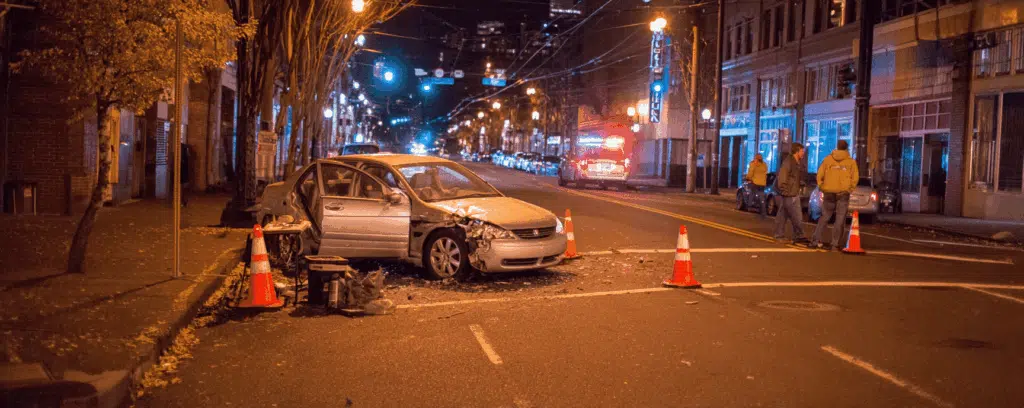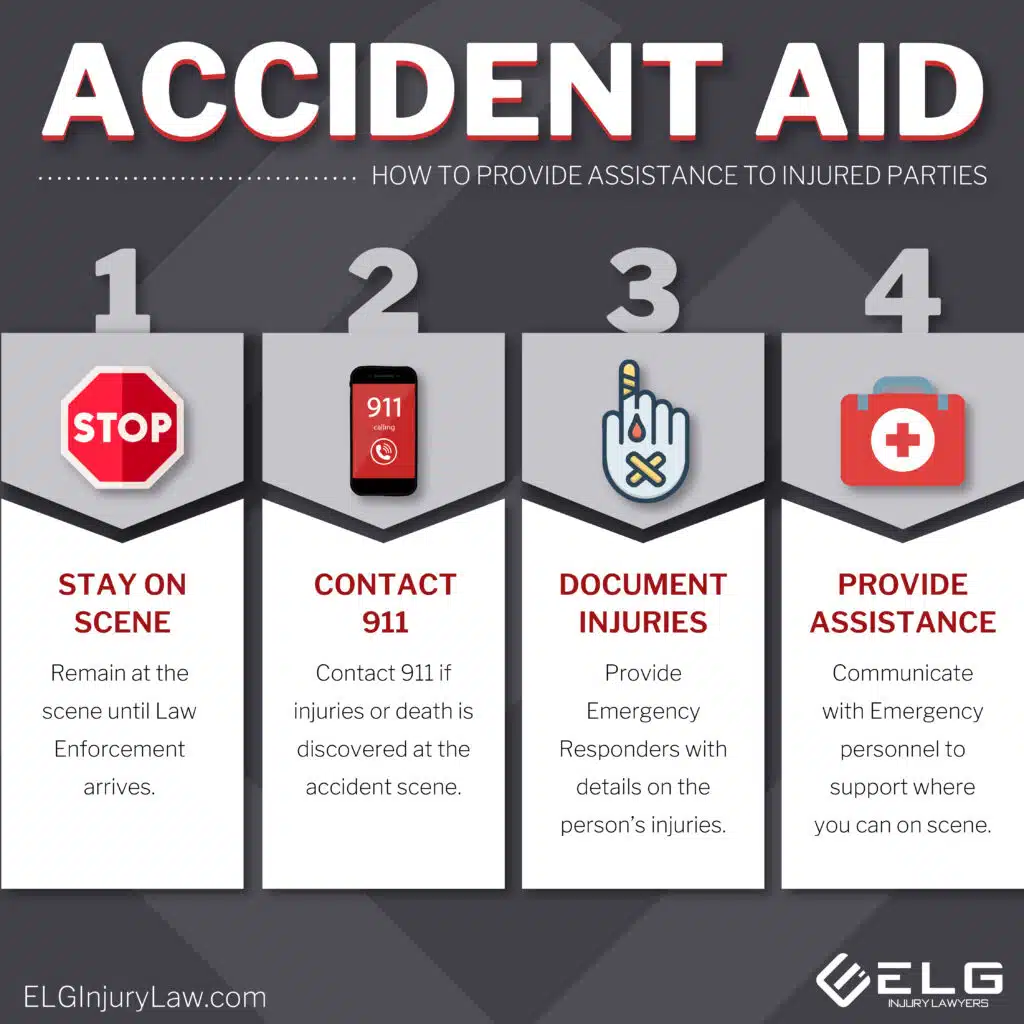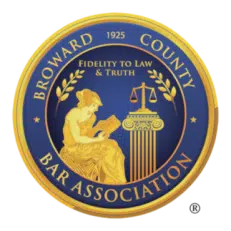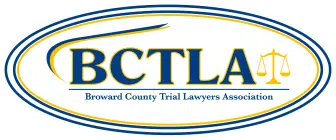
ORS hit-and-run laws in Oregon lay out critical responsibilities for drivers involved in accidents. You must stop, exchange your information, help any injured persons, and notify law enforcement. Ignoring these duties can lead to serious penalties like fines or jail time. In this article, we’ll detail these responsibilities and the specific penalties for non-compliance, ensuring you know exactly what’s at stake.
Key Takeaways
- Oregon law mandates that drivers involved in accidents must stop, exchange information, render aid, and notify law enforcement to comply with hit-and-run regulations.
- Penalties for hit-and-run incidents in Oregon vary based on the severity of the accident and can include hefty fines, prison time, and loss of driving privileges.
- Educational initiatives for young and new drivers are essential to inform them of their legal obligations and the serious consequences of failing to comply with hit-and-run laws.
Definition and Scope of ORS Hit and Run Laws
In Oregon, a hit-and-run is defined as the failure to perform duties after being involved in an accident. This definition encompasses a wide range of scenarios, from minor fender-benders to serious collisions resulting in injury or death. The Oregon Revised Statutes (ORS) lay out specific duties that drivers must perform to comply with the law, ensuring that all parties involved receive the necessary information and assistance.
The scope of these laws extends beyond merely stopping at the scene. Drivers must also exchange information, provide reasonable assistance to injured persons, and notify law enforcement when required. Failure to adhere to these duties can lead to severe penalties for such a person involved, including fines and imprisonment, depending on the circumstances of the incident.
Knowing these obligations helps drivers avoid the harsh consequences of a hit-and-run charge.
Duties of Drivers Involved in Accidents
Oregon law mandates that drivers involved in an accident must stop immediately and assess the situation, especially if the accident results in property damage or injury. The duties of a driver extend beyond just stopping; they must also exchange names, addresses, and other pertinent information with all other parties involved in the accident. This exchange ensures that all parties can follow up on damages caused and seek appropriate compensation.
In cases where injuries are involved, the responsibilities increase significantly. Drivers are legally obligated to:
- Render aid to injured persons, which includes providing reasonable assistance.
- Ensure that emergency services are notified if needed.
- Understand that helping injured individuals and sharing their identity with emergency services is a legal requirement, not just a moral one.
- Provide assistance that can range from calling 911 to staying at the scene until help arrives.
Moreover, drivers must notify law enforcement if the accident results in significant property damage, injury, or death. This notification helps create an official record of the incident, which can be vital for insurance claims and legal proceedings. Performing these duties helps drivers avoid the severe consequences of a hit-and-run charge.
Penalties for Failing to Perform Duties

Penalties can include substantial fines and possible imprisonment for not complying with the responsibilities after an accident resulting from a failure to perform duties. The legal system takes a failure to perform duties very seriously, as it undermines the safety and well-being of all road users.
Therefore, understanding and adhering to the following duties is not only a legal obligation but also a crucial step in fostering a good-faith effort to create a safe driving environment for everyone.
Criminal Classifications and Penalties
Criminal charges for hit-and-run incidents in Oregon vary based on the extent of property damage or injury incurred. Oregon law categorizes these incidents into different classifications, each carrying specific penalties. Understanding these classifications can help drivers recognize the serious repercussions of leaving the scene of an accident.
Hit-and-run incidents that involve serious physical injury can carry heavy sentences. Failing to perform duties related to an injured person may lead to a criminal charge of either a Class B or Class C felony. Additionally, drivers can face fines, prison sentences, and monetary penalties for damages under the Oregon Revised Statutes.
The next sections will detail these classifications and their penalties.
Class C Felony for Hit and Run
A Class C felony hit-and-run in Oregon is a serious criminal charge that comes with severe consequences. If convicted, the offender may face a monetary penalty of up to $125,000 and a potential prison sentence of up to five years. The gravity of this charge underscores the importance of adhering to legal duties after an accident.
The potential for up to five years of incarceration illustrates how seriously Oregon takes hit-and-run offenses, especially when they involve injury or substantial property damage. This classification aims to deter drivers from fleeing the scene and to encourage them to fulfill their legal obligations.
Class B Felony for Hit and Run
When a hit-and-run accident results in severe injury or fatality, the crime is elevated to a Class B felony, which carries even more stringent penalties. Serious injuries or fatalities from a hit-and-run can lead to a prison term of up to 10 years and fines that can reach $250,000. This classification reflects the heightened severity of incidents that result in significant harm or loss of life.
The severe penalties associated with a Class B felony underscore the critical importance of remaining at the scene of an accident and fulfilling all legal duties. These stringent measures are designed to ensure that injured persons receive immediate assistance and that justice is served.
Misdemeanor Hit and Run
Hit-and-run incidents involving only property damage are categorized as Class A misdemeanors in Oregon. These cases, while less severe than those involving injuries, still carry significant penalties. Offenders may face fines up to $5,000 and a possible jail term of one year.
The classification of misdemeanor hit-and-run highlights the seriousness with which Oregon treats all hit-and-run incidents, regardless of the extent of damage. This approach aims to discourage drivers from leaving the scene of any accident, ensuring that all damages are appropriately addressed.
Let's Settle For More... Get Your FREE Case Review Today.
Let's Settle For More... Get Your FREE Case Review Today.
Specific Situations Covered by ORS
Oregon law specifies particular scenarios that require drivers to fulfill certain duties after being involved in a collision. The legal ramifications for hit-and-run incidents can differ significantly depending on whether property damage or injury occurs.
The next sections will offer a detailed overview of these specific circumstances.
Property Damage and Unattended Vehicles
If a driver hits an unoccupied vehicle, they must attempt to locate the owner. If unsuccessful, they are required to leave a written notice giving the driver’s name and address, and a brief description of the incident. This ensures that the owner of the vehicle can follow up on the damages caused and seek appropriate compensation.
Following these legal requirements is essential to avoid penalties and ensure responsible behavior from drivers involved in accidents. It demonstrates a commitment to accountability and helps maintain trust among road users.
If immediate medical care is needed, drivers must:
- Ensure that the other occupants of the other vehicle provide their information.
- Provide immediate assistance.
- Notify authorities.
- Fulfill their legal responsibilities.
By following these steps, a driver can avoid hit-and-run charges and help ensure that injured persons receive secure medical care and medical care.
Animal-Related Accidents
Drivers involved in accidents with animals have specific obligations to fulfill:
- They must take reasonable steps to assist the injured animal.
- They must contact the animal’s owner or the appropriate authorities.
- If a driver injures an animal in an accident, they must make an effort to assist the animal’s injuries and notify the appropriate authorities.
Reporting the incident to local authorities or animal control is also mandatory. These steps ensure that the animal receives the necessary care and that the incident is properly documented.
Financial and Legal Consequences
Individuals convicted of a hit-and-run may face significant financial liabilities. These liabilities include compensation for medical expenses, lost wages, and other damages incurred by victims. The financial and legal consequences of a hit-and-run incident can have long-lasting effects on an individual’s life and future driving opportunities.
In addition to financial liabilities, hit-and-run convictions can lead to the suspension or revocation of driving privileges. The following subsections will explore these consequences in more detail.
Compensation for Damages
Convictions for hit-and-run incidents can lead to significant financial liabilities, including restitution for damages and legal fees. Victims, including persons injured, can claim compensation for a range of damages, such as medical expenses, lost wages, and pain and suffering.
Expenses related to medical treatment and property damage can be recovered through various insurance policies, including uninsured motorist coverage. In Oregon, victims can claim compensation through different insurance policies available, which include liability coverage and uninsured motorist protection.
Impact on Driving Privileges
A hit-and-run conviction can lead to the suspension or loss of driving privileges, with the length of these penalties influenced by the severity of the incident. The duration of the suspension can vary based on the circumstances of the incident.
Mandatory suspension of driving privileges granted is a common consequence of hit-and-run convictions. This penalty serves as a strong deterrent against leaving the scene of an accident and underscores the importance of fulfilling legal obligations.
Role of Law Enforcement and Legal Representation
Law enforcement plays a crucial role in hit-and-run investigations, gathering evidence and witness statements to build a case. Notifying a police officer immediately after an accident is vital for legal proceedings and documentation. The importance of police notification cannot be overstated, as it aids in the proper handling of the situation and potential legal follow-up. When the police officer arrives, they can further assist in the investigation.
The next section will delve into this aspect in more detail.
Importance of Police Notification
Immediate police notification is crucial as officers gather evidence and provide assistance at the scene. Drivers should contact law enforcement to immediately report the accident, which is a requirement under Oregon law. Informing the police immediately after an accident can significantly aid in the proper handling of the situation and potential legal follow-up.
This action helps ensure that all parties receive the necessary support and that the incident is thoroughly documented.
Preventative Measures and Best Practices
Drivers should:
- Stop at the scene of the accident
- Assess any injuries
- Render aid
- Exchange information with other involved parties
- Provide the driver’s information to other parties involved
These steps help avoid hit-and-run charges. Educating young and new drivers about their legal obligations after a vehicle accident is crucial for preventing hit-and-run incidents, as they may be unaware of the severe consequences of failing to comply with the law.
The next sections will detail steps to take after an accident and emphasize the importance of educating young and new drivers.
Steps to Take After an Accident
In the aftermath of an accident, taking the right steps can make all the difference. First and foremost, drivers should immediately stop and move the vehicle to the shoulder if it is safe to do so, ensuring that they do not obstruct traffic or create additional hazards. Next, it is crucial for drivers to exchange their personal and vehicle information with the other party and the vehicle involved in the accident. This includes names, contact details, and insurance information.
If the accident involves an unattended vehicle, the driver must leave a note with their contact information and a brief description of the incident. Timely filing of insurance claims is also essential following a hit-and-run, as it can expedite the process of receiving owed compensation.
By following these steps, drivers can ensure they comply with legal requirements and avoid the severe consequences of a hit-and-run charge.
Educating Young and New Drivers
Young drivers often react impulsively in accidents, making education a key preventative measure. Informing them about their responsibilities and the severe penalties associated with hit-and-run incidents can help prevent such behavior. Educational programs can significantly reduce the likelihood of young drivers engaging in hit-and-run behavior by teaching them the importance of remaining at the scene, exchanging information, and providing aid.
Preventative strategies include ensuring all vehicle occupants wear seat belts and understanding vehicle safety features. By instilling these practices early, young drivers can develop responsible habits that will serve them well throughout their driving careers.
Frequently Asked Questions
What constitutes a hit-and-run in Oregon?
A hit-and-run in Oregon constitutes failing to stop, exchange information, or provide aid after being involved in an accident. Such actions are legally required to ensure accountability and support for those affected.
What are the penalties for a Class C felony hit-and-run?
A Class C felony hit-and-run in Oregon can lead to a fine of up to $125,000 and a prison sentence of up to five years. Such serious consequences underscore the gravity of the offense.
What should I do if I hit an unattended vehicle?
If you hit an unattended vehicle, it is essential to try to find the owner. If you cannot locate them, leave a written notice containing your name, address, and a brief account of the incident.
How does a hit-and-run conviction impact driving privileges?
A hit-and-run conviction typically results in the suspension or loss of driving privileges, with the length of the penalty varying based on the incident’s severity. Consequently, it significantly jeopardizes one’s ability to legally operate a vehicle.
Why is it important to notify the police immediately after an accident?
Notifying the police immediately after an accident is vital because it ensures that officers can collect evidence and establish an official record, which is essential for any legal proceedings and documentation. This action not only helps in resolving disputes but also provides necessary support at the scene.
Related Articles
Understanding the Oregon Total Loss Threshold: Key Facts for Car Owners
Last updated Thursday, September 4th, 2025







